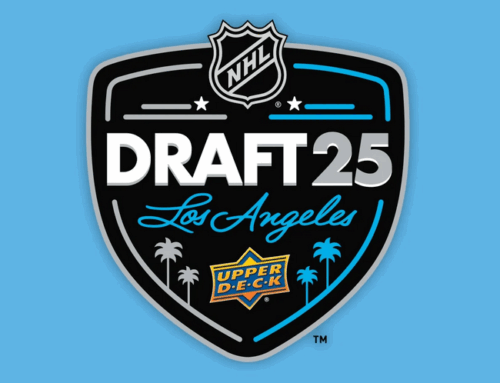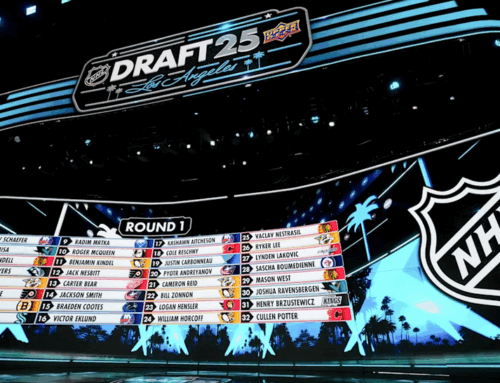Prospect Ramblings: Insights from Mitch Brown’s CHL/USHL/NCAA Tracking Data
Ben Gehrels
2023-01-25
Cover image: The Hockey News
For only three bucks a month, you can get access to Mitch Brown’s incredible microstat database, complete with detailed player cards and informative visualizations. Join his Patreon here. He manually tracks a variety of useful metrics across five categories—shooting, passing, transition, defence, and miscellaneous—to provide a clear picture of how these players are impacting the game. Very meticulous work!
Without giving too much away for free, I would like to focus my ramblings this week on sharing some insights gleaned from Brown’s tracking data on players from the CHL, USHL, and NCAA. As an initial caveat, his data sets are quite small for the moment, so take these early observations with a grain of salt; trends will firm up as seasons continue and the data set grows more robust.
Forwards
Zach Benson (2023)
As you might expect, Connor Bedard sticks out on the far end of the overall Expected Goals per 60 Minutes (xG/60). However, Zach Benson actually appears to be the biggest outlier on the chart on the strength of his bonkers 2.59 Primary Expected Assists per 60 Minutes (xA1/60). Benson is a dynamic, intelligent playmaker currently sporting an insane 1.71 points-per-game pace as a draft eligible—a mark that would have bested everyone in the 2022 class by a fair margin except Liam Ohgren’s 1.93 ppg in the Swedish J20, a lower-tier league than the WHL.
But Benson still slots in at fifth overall right now on most 2023 rankings, a testament to the elite talent at the top of this draft but also a reflection of the fact that he is 5-10 and 150 pounds right now. That’s small, even with the NHL trending in the direction of speed and skill. He is only 17, however, and has lots of time to bulk up before he hits the majors. It is going to be a fun draft season in fantasy, and Benson will be one of the top players to target after the big four (Bedard, Adam Fantilli, Leo Carlsson, and Matvei Michkov) are off the board.
Check out this insane seeing-eye pass from Benson to teammate Matt Savoie (BUF, 2022):
Adam Fantilli (2023)
Speaking of Fantilli, Brown’s early data makes Fantilli look relatively human after a blistering hot start to the NCAA season with Michigan. He sits fourth among 2023 eligibles in xG/60 behind Bedard, Quentin Musty, and Coulson Pitre and can be found way down at 21st in xA1/60. Keep in mind that this data does not include prospects in Europe like Carlsson and Michkov. Of course, Fantilli’s 6-2 frame, rangy dominance, and 33 points in only 20 NCAA games as a draft eligible still make him a very attractive choice at second overall behind Bedard. But especially after a WJC at which Fantilli was asked to play more of a depth role, the gap between him and Carlsson in particular remains razor thin.
Luke Misa (2024)
Luke, the older brother of top 2025-eligible skater Michael Misa, currently has the second-highest primary xA1/60 behind Zach Benson (2023), narrowly edging out Logan Stankoven (DAL, 2021). Although Misa’s totals (20 points in 43 games) do not really stand out, Brown’s per 60 tracking suggests that Misa is doing very well with limited ice time. He will be a key player to watch heading into next year’s draft. Look for him to take a significant step forward when elevated to a top-line role.
Ben Hemmerling (VGK, 2022)
Hemmerling was not a player I was familiar with before digging into this data set. He was a sixth-round pick by Vegas at last year’s draft and has been a leader on a weak Everett squad this year in the WHL; aside from Olen Zellweger, who has now been traded to Kamloops, Hemmerling is one of only two drafted players on the Silvertips. He stands out here for having an above-average balance of both xA1/60 and xG/60. Although likely destined for a bottom-six role at the highest level, this season is increasing his likelihood of becoming an NHLer. Not bad for someone taken 177th overall!
Brayden Yager (2023)
After entering 2022-23 as a consensus top-ten talent, Yager has been a faller on many rankings throughout the year and the data set supports that perception: he is below average for xA1/60, which is not necessarily a surprise given his M.O. as a sniper, but he is also only mid-pack for xG/60. In the public sphere, Craig Button/TSN (11th), Smaht Scouting (12th), Dobber Prospects (14th), and Elite Prospects (23rd) have him ranked outside the top ten while eight other sources still have him inside the top ten. If a big name (besides Michkov) is going to fall on draft day, it might just be Yager. He just has not stood out this year in general, not even for the goal-scoring that is supposed to be his calling card.
Defenders
Lane Hutson (MON, 2022)
Hutson dominates this chart visually because he is alone in the top right, well above average in both xA1/60 and xG/60. He is having a special D+1 season. And he is also still growing. It was exciting to learn recently that Hutson now stands at 5-10 because that means he is no longer exceptionally sized, which shortens his Breakout Threshold from 400 to 200 games.
The list of defenders of Hutson’s size who have succeeded in the NHL is extremely short and basically only includes Torey Krug and Jared Spurgeon. If Hutson maintains his current trajectory, he has a chance to be better than both those players:
Here are the kinds of plays that have been influencing Brown’s data on Hutson. His puck touches are noticeable because of his non-stop motor, shiftiness, and creativity with both handling and passing. He waits until seams open up and then quickly exploits them with unexpected passes to open teammates. Also encouraging to see in these clips is his confidence both pinching in and holding the line to disrupt zone exits.
Olen Zellweger (ANA, 2021) and Pavel Mintyukov (ANA, 2022)
Out of all defenders—besides Hutson—who also are above-average distributors (xA1/60), Zellweger and Mintyukov lead the way in terms of xG. The underlying data supports their massive offensive totals: both players have a good chance at becoming NHL stars because they excel in transition and can hold their own on the defensive side of things. Although Mintyukov was unable to play at the 2023 WJC because of Team Russia’s suspension, Zellweger featured heavily for the gold-medal-winning Canadian squad; his straight-line speed and four-way mobility are both strengths, and he looked dangerous on offence and held his own on defence.
The situation the Ducks find themselves in with these two coming up and Jamie Drysdale still growing into his potential at the NHL level reminds me of a similar situation this club dealt with back in 2015-16: Cam Fowler (2010) had just begun pushing 40 points regularly, and Brandon Montour (2014) and Shea Theodore (2013) were getting shuttled back and forth between Anaheim and San Diego (AHL) attempting to stick in the big leagues. Fast forward to 2023 and all three have made significant impacts in the NHL, albeit for three different teams: the dependable Fowler has averaged 37 points across nearly 900 games; Theodore is probably the most offensively dynamic, pacing for over 50 points the last four years; and Montour is currently pacing for 70 points with the Panthers, though his career average is closer to Fowler’s sub-40 mark.
I suspect the Duck’s modern three-headed monster has even more upside than the 2015-16 one. In case you missed it, check out my argument for why Drysdale is still the best of the three to invest in for fantasy purposes.
Final Quick Hits
Connor Bedard (2023) is not actually first right now in xG/60—that honour goes to Justin Gill (2023), an undrafted overager playing in the QMJHL who currently has 32 goals in 44 games. I can’t confirm without checking his Time On Ice stats, but my hunch is that Gill gets a boost for earning that production without a ton of ice time. He is an outlier in the data set who will regress as more games are tracked. He is currently goalless in his last seven games, for instance, whereas Bedard has 15 goals in his last seven. I’m only including Gill here to explain why Bedard is not currently first in xG/60.
Third overall in xG/60 is Mathew Seminoff (DAL). Seminoff, a savvy sixth-round snag by the Stars last year, is an offence-first winger with a great shot, playmaking ability, and spatial awareness whose ranking was held down by his clunky skating technique. For him, his NHL chances hinge almost entirely on his ability to improve his skating.
Stanislav Svozil (CBJ) is still average in xG/60 but now rates above average in xA1/60, suggesting that his sparkling performance at the WJCs was no accident. If he can continue to grow the offensive side of his game, he has the makings of a complete, top-four defender for Columbus.
Heartening to see Dmitri Kuzmin (WPG) posting above-average rates for both xA1/60 and xG/60. He remains an intriguing offensive defender who has not received a lot of hype because of his unconventional development path through the Belarussian system. He is pushing a point per game in his second OHL season after crossing over to North America. Kuzmin first caught my eye because of the lavish praise heaped on him by Tony Ferrari ahead of the 2021 draft in his DP profile; Ferrari wrote, “Should he slip outside of the third or fourth round, he could be arguably the steal of the draft with his predatory and aggressive mindset in every facet of the game.” Managers in need of a long-shot, swing-for-the-fences type player who is almost assuredly available for free off the wire should consider Kuzmin.
2023-eligible Luca Cagnoni leads all defenders in the data set in xA1/60 by a wide margin. He is currently ranked in the 25-74 range. Most outlets see him as a late-first, early second-round pick, but that 74th overall billing is from Bob Mackenzie, who generally offers the most accurate reflection of what NHL GMs are actually thinking. Cagnoni is driving the bus for Portland (WHL) with 39 points in 41 games so far as the Winterhawks’ top defender.
Also on the Winterhawks, Marek Alscher (FLA) was selected in the third round last year by the Panthers with their first pick of the draft. He is a big-framed defenceman (6-3, 196lbs) who was drafted more for his physicality and shutdown-style play but he is doing surprisingly well (ie. above CHL average) in terms of xA1 this year.
Finally, I just wanted to point out that we have a new Byfuglien working his way towards the majors and his name is Thor. He is former Jets blueliner Dustin’s second cousin but stands at 5-9 and weighs in at less than 150 pounds. His NHL chances are not looking good but I just wanted the chance to type “Byfuglien” again after having painstakingly learned it by rostering Dustin for all those years.
—
Thanks for reading! Follow me on Twitter @beegare for more prospect content and fantasy hockey analysis.





